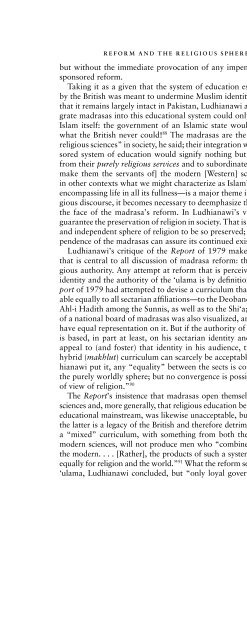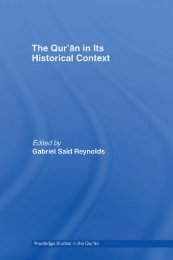Download (1 MB) - Islam and Christian-Muslim Relations: Articles ...
Download (1 MB) - Islam and Christian-Muslim Relations: Articles ...
Download (1 MB) - Islam and Christian-Muslim Relations: Articles ...
Create successful ePaper yourself
Turn your PDF publications into a flip-book with our unique Google optimized e-Paper software.
REFORM AND THE RELIGIOUS SPHERE 79but without the immediate provocation of any impending governmentsponsoredreform.Taking it as a given that the system of education established in Indiaby the British was meant to undermine <strong>Muslim</strong> identity <strong>and</strong> culture, <strong>and</strong>that it remains largely intact in Pakistan, Ludhianawi argued that to integratemadrasas into this educational system could only mean destroying<strong>Islam</strong> itself: the government of an <strong>Islam</strong>ic state would thereby achievewhat the British never could! 88 The madrasas are the “defenders of thereligious sciences” in society, he said; their integration with the state-sponsoredsystem of education would signify nothing but to “prevent themfrom their purely religious services <strong>and</strong> to subordinate them to [literally:make them the servants of] the modern [Western] sciences.” 89 Thoughin other contexts what we might characterize as <strong>Islam</strong>’s “worldliness”—encompassing life in all its fullness—is a major theme in the ‘ulama’s religiousdiscourse, it becomes necessary to deemphasize this ‘worldliness’ inthe face of the madrasa’s reform. In Ludhianawi’s view, the madrasasguarantee the preservation of religion in society. That is, there is a separate<strong>and</strong> independent sphere of religion to be so preserved; <strong>and</strong> only the independenceof the madrasas can assure its continued existence.Ludhianawi’s critique of the Report of 1979 makes explicit an issuethat is central to all discussion of madrasa reform: the question of religiousauthority. Any attempt at reform that is perceived to threaten theidentity <strong>and</strong> the authority of the ‘ulama is by definition suspect. The Reportof 1979 had attempted to devise a curriculum that would be acceptableequally to all sectarian affiliations—to the Deob<strong>and</strong>is, Barelawis, <strong>and</strong>Ahl-i Hadith among the Sunnis, as well as to the Shi‘a; the establishmentof a national board of madrasas was also visualized, <strong>and</strong> all sects were tohave equal representation on it. But if the authority of a religious scholaris based, in part at least, on his sectarian identity <strong>and</strong> on his ability toappeal to (<strong>and</strong> foster) that identity in his audience, then a “mixed” orhybrid (makhlut) curriculum can scarcely be acceptable. Further, as Ludhianawiput it, any “equality” between the sects is conceivable only “inthe purely worldly sphere; but no convergence is possible from the pointof view of religion.” 90The Report’s insistence that madrasas open themselves to the modernsciences <strong>and</strong>, more generally, that religious education be integrated into theeducational mainstream, was likewise unacceptable, but not only becausethe latter is a legacy of the British <strong>and</strong> therefore detrimental to <strong>Islam</strong>. Fora “mixed” curriculum, with something from both the religious <strong>and</strong> themodern sciences, will not produce men who “combine the medieval <strong>and</strong>the modern. ...[Rather], the products of such a system would be uselessequally for religion <strong>and</strong> the world.” 91 What the reform seeks to create is not‘ulama, Ludhianawi concluded, but “only loyal government servants.” 92



